Bats: Shedding Light on Nocturnal Wildlife
By Vona Kuczynska, biologist with Wildheart Ecology
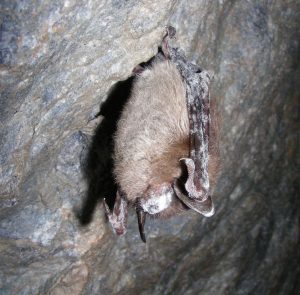
If someone asked you to name ten different kinds of mammals, you may list off zebras, elephants, tigers, chimpanzees, or even dogs or cats. What may not immediately come to mind are bats, even though they make up one fifth of all mammals on our planet! There are approximately 1,100 different species, or types of bats, and they are the only mammal capable of true, sustained flight. Unfortunately, bats are experiencing massive die-offs worldwide, including here in Monroe County and the rest of the Midwest. In 2006, White nose syndrome, a fungal disease that affects bats, was introduced to the United States from Europe. The fungus, Pseudogymnoascus destructans, or Pd for short, affects bats that hibernate in caves during the winter. Pd causes bats to wake up during hibernation which leads to dehydration, starvation, and often death. Because many bats roost communally in large clusters in many of the same caves, the disease spreads quickly from individual to individual. The disease is still spreading its way across the US and into Canada, killing millions of bats. To date, there is no cure to this devastating disease.
Bats provide humans with numerous important services. In southern parts of the world, bats pollinate many kinds of plants that we consume, including delicious bananas, mangos, figs, cashews, dates, peaches, cocoa and many other food crops. In the Midwest, insect eating bats provide invaluable pest control services to agricultural farmers by consuming millions of crop and produce-eating insects. Bats also benefit city-dwellers by consuming tons of pest insects, including mosquitoes and spiders. Based on one estimate, bats eat 62 tons of insects each year in Monroe County.
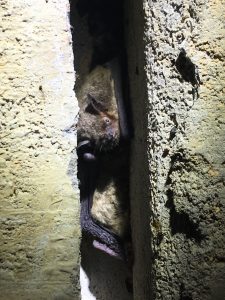
Monroe County is home to ten species of bats. During the year, “cave bats”, such as the gray bat, rely on caves or abandoned quarries and mines year-round as roost sites, while other species never inhabit caves at all. Such “tree bats,” including the eastern red bat and hoary bat, rely on trees and the leaf litter in forests for shelter all year long. Several species fall somewhere in between, using caves in the winter and trees during the summer months. Some species, such as the gray and big brown bat, may even use cracks and crevices of bridges and take up residence in culverts. Bats that live in forests rely on live trees with exfoliating bark, such as shagbark hickory, and dead standing trees with sloughing bark, cracks, and crevices for shelter and roost sites to raise young. For this reason, it’s important that property owners retain dead standing trees, unless they pose a safety hazard. Oak-hickory forests in Monroe County with white oak and shagbark hickory trees provide valuable roosting habitats to many bats. Prairies, wetlands, and forested riparian corridors in the county support a diversity of insects and serve as valuable foraging grounds during the spring, summer, and fall.
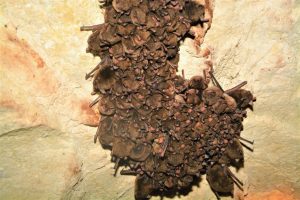
Like many types of birds, some species of bats spend their summers in Illinois, but migrate to warmer areas during the fall to places where food resources remain abundant during the winter. Some species will make more local migrations of just a hundred or few hundred miles, while others will head as far as Mexico or other Latin American countries. Migratory bats include the hoary, silver-haired, evening, gray, and eastern red bat. The remaining species will move to caves, as well as abandoned mines, and quarries and enter hibernation as temperatures drop and insects stop being active, typically by November. Year-round residents include the little brown, Indiana, northern long-eared, big brown, and tri-colored bat. Monroe County boasts more caves than any other county in Illinois, so it’s no surprise that many cave-dependent species are found here. Winter residents will snooze for five or so months, relying solely on body fat until mid-March to early April, when the spring brings fresh foliage, and with it a fresh supply of insects that will be help restore depleted fat reserves used all winter.
North American bat species breed in late fall, just before they go into winter hibernation. Female bats store the semen and don’t ovulate and give birth until the following spring. In the spring, overwintering bats will leave caves and head for forested grounds, where they will give birth and raise one to two young, called “pups” during the summer. Most litters consist of one, and rarely two, offspring, that each weigh about one third of the mother’s weight. Like all mammals, female bats breast-feed their young, and once they are able to fly, mothers will introduce their offspring to their forested home grounds, and teach their young to hunt for insects on the wing.
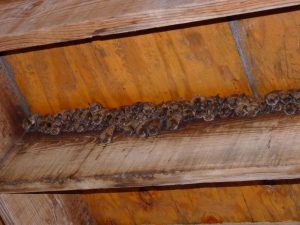
While many bats depend on forests for roosting and foraging, a few species, such as the big brown bat, are very adapted to living in urbanized settings. Big brown bats are frequently observed skimming the surface water of pools and foraging for insects around porch and street lights at night. They may even decide to take up residence and raise young in older attics of houses or barns during the summer. Some may become unwelcomed guests and can be safely removed with the help of wildlife pest experts in the fall. Others take up residence in dead standing trees on properties and can be enjoyed from a distance.
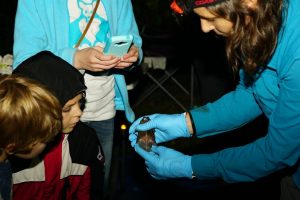
While many bats are in decline, the good news is that land managers, land-owners and bat-enthusiasts alike can take plenty of actions to help our night-time friends recover. Wildheart Ecology is an organization that relies on science education to promote wildlife conservation. The group is comprised of Midwest biologists who study bats and enjoy teaching others about midwestern bats through exciting, active programs. To learn more about Wildheart Ecology and their events, visit www.wildheartecology.com.
CLIFFTOP, a local nonprofit organization, is focused on preserving and protecting area blufflands.
A version of this article appeared in the September 6, 2019 edition of the Monroe County Independent.
© 2019 all content rights reserved Clifftop NFP
Comments are currently closed.
